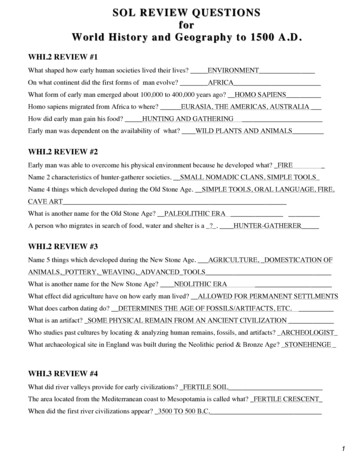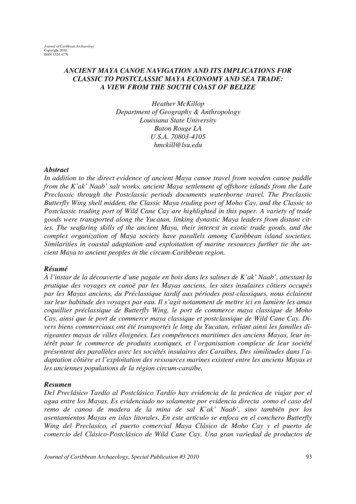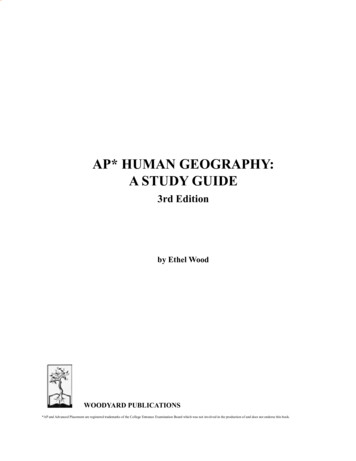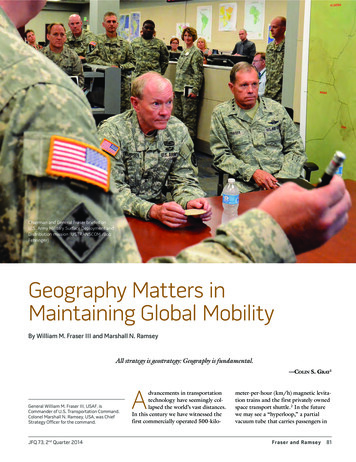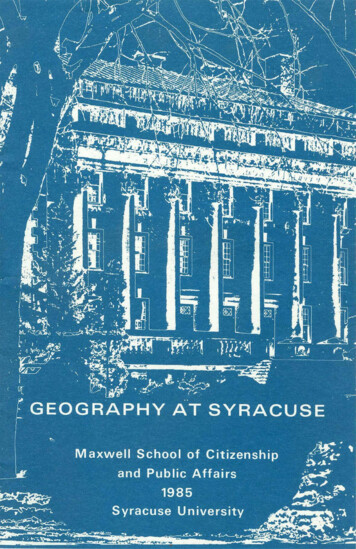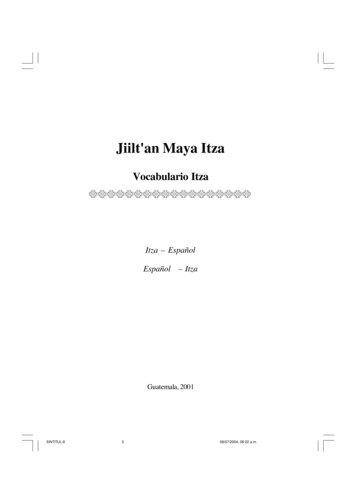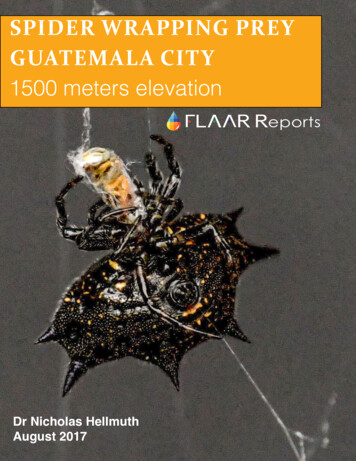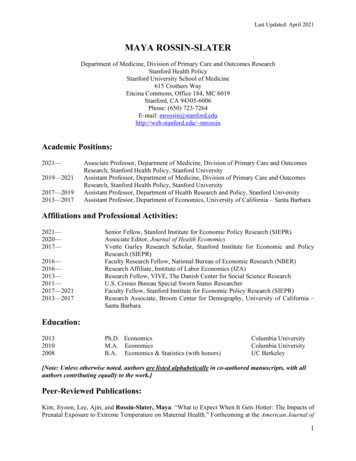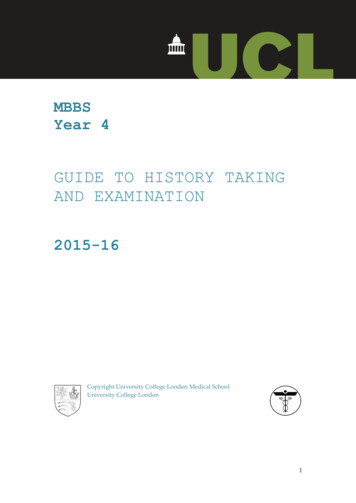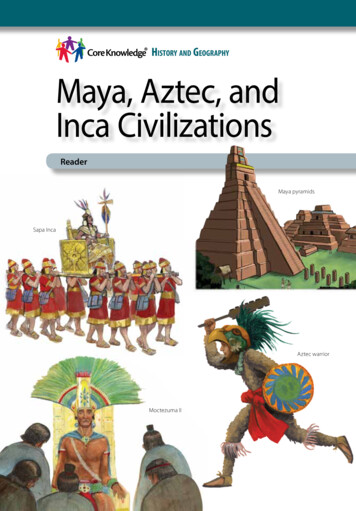
Transcription
History and GeographyMaya, Aztec, andInca CivilizationsReaderMaya pyramidsSapa IncaAztec warriorMoctezuma II
Book No.Enter informationin spacesto the left asinstructed.ISSUED TOYearUsedCONDITIONISSUEDRETURNEDPUPILS to whom this textbook is issued must not write on any page or markany part of it in any way, consumable textbooks excepted.1. T eachers should see that the pupil’s name is clearly written in ink in thespaces above in every book issued.2. The following terms should be used in recording the condition of the book:New; Good; Fair; Poor; Bad.
Maya, Aztec, andInca CivilizationsReader
Creative Commons LicensingThis work is licensed under aCreative Commons Attribution-NonCommercial-ShareAlike4.0 International License.You are free:to Share—to copy, distribute, and transmit the workto Remix—to adapt the workUnder the following conditions:Attribution—You must attribute the work in thefollowing manner:This work is based on an original work of the CoreKnowledge Foundation (www.coreknowledge.org) madeavailable through licensing under a Creative CommonsAttribution-NonCommercial-ShareAlike 4.0 InternationalLicense. This does not in any way imply that the CoreKnowledge Foundation endorses this work.Noncommercial—You may not use this work forcommercial purposes.Share Alike—If you alter, transform, or build upon this work,you may distribute the resulting work only under the same orsimilar license to this one.With the understanding that:For any reuse or distribution, you must make clear toothers the license terms of this work. The best way todo this is with a link to this web /4.0/All Rights Reserved.Core Knowledge , Core Knowledge Curriculum Series ,Core Knowledge History and Geography and CKHG are trademarks of the Core Knowledge Foundation.Trademarks and trade names are shown in this bookstrictly for illustrative and educational purposes and arethe property of their respective owners. References hereinshould not be regarded as affecting the validity of saidtrademarks and trade names.ISBN: 978-1-68380-030-9Copyright 2016 Core Knowledge Foundationwww.coreknowledge.org
Maya, Aztec, andInca CivilizationsTable of ContentsChapter 1The Maya: Rainforest Civilization. . . . . . . . . . . . . . 2Chapter 2Maya Science and Daily Life. . . . . . . . . . . . . . . . . . . . 10Chapter 3The Aztec: Empire Builders. . . . . . . . . . . . . . . . . . . . . 20Chapter 4Tenochtitlán: City of Wonder . . . . . . . . . . . . . . . . . . 28Chapter 5The Inca: Lords of the Mountains . . . . . . . . . . . . . 36Chapter 6Inca Engineering. . . . . . . . . . . . . . . . . . . . . . . . . . . . . . . . . 44Chapter 7The End of Two Empires . . . . . . . . . . . . . . . . . . . . . . . . 54Glossary. . . . . . . . . . . . . . . . . . . . . . . . . . . . . . . . . . . . . . . . . . . . . . . . . . . . . . 64
Maya, Aztec and Inca CivilizationsReaderCore Knowledge Sequence History and Geography 5
Chapter 1The Maya: RainforestCivilizationThe Vanishing Civilization Do youThe Big Questionlike mysteries? Try this one: MoreWhat do the ruinsthan a thousand years ago, a greatof the Maya tell youcivilization of American Indian peoples about the importanceof religion to theirbuilt cities across Mesoamerica—ancivilization?area today that is made up of partsof Mexico and Central America. Theybuilt stone temples and pyramids that rose far above theforest treetops.VocabularyMesoamerica, n. ahistorical region thatincludes what are todaythe central and southernparts of Mexico andthe northern parts ofCentral AmericaThe Maya, one group of native peoples,discovered important mathematical ideas.They also studied the movements of thestars. Using this knowledge, the Mayamade a calendar almost as accurate as theone we use today. Then, after hundredsof years of growth, many key elements ofMaya civilization disappeared. The people abandoned theironce-thriving cities. This great urban society and many of2
NORTH AMERICAThe MayaThe AztecAtlantic OceanCENTRALAMERICASOUTH AMERICAPacific OceanNWEThe IncaSIn the centuries before Europeans came to the Americas, great civilizations thrived in present-dayMexico, Central-America, and South America. These included the Maya, Aztec, and Inca.3
its traditions were mysteriouslytransformed, although Mayan-speakingpeople continue in this part ofMesoamerica to the present.This may sound like the plot of a sciencefiction movie, but it isn’t. In fact, it is a shorthistory of the Maya (/mah*yuh/), one ofthe first great civilizations of the Americasthat flourished between 200 and 900 CE.Ruins in the Rain ForestIn 1839, two American explorers heard storiesof mysterious ruins in the rain forests ofCentral America. Curious, they set out to seefor themselves. The two men first exploredVocabularyMaya, n. a group ofpeoples who haveinhabited a regionthat includes parts ofpresent-day Mexico andCentral America fromthousands of yearsago to the present.Before the arrivalof Europeans, Mayacities and civilizationthrived in rainforestlocations betweenabout 200 and 900 CE.civilization, n. a society,or group of people,with similar religiousbeliefs, customs,language, and form ofgovernmentthe remains of theVocabularycity of Copánarchitecture, n. thestyle and constructionof a building(/koh*pahn/) inthe present-daycountry ofHonduras. From the architecture, itwas clear the ruins had been left byan ancient and advanced civilization.The two Americans continued theirjourney, exploring many other ruins.Then, they returned to the UnitedStates and wrote a best-selling bookArchaeologists still study the remarkable Maya.4
about their findings. Their tales and drawingsinspired worldwide interest in the history ofthe Maya.Since the mid-1800s, archaeologistsand other experts have continued tostudy these remarkable people. Recentbreakthroughs in research have revealedjust how much the Maya accomplished.Let’s take a closer look at what we knowabout them and what still remainsa mystery.At its peak, the Maya civilization includeda large group of city-states that wereVocabularyarchaeologist, n. anexpert in the studyof ancient peopleand the objects fromtheir time period thatremain, generallyincluding stones andbones, and potterycity-state, n. acity that is anindependent politicalstate with its ownruling governmenttemple, n. a buildingwith a religious use ormeaningallied with, fought, and conquered eachother. These cities were located on the Yucatán Peninsulain what is today southeastern Mexico and the countriesof Guatemala,Honduras, and Belize.Archaeologists believethat Maya civilizationreached its greatestextent between about200 and 900 CE.The largest buildingsin Maya cities werepyramids that alsoserved as temples.Maya pyramids were grand monuments that reachedtoward the sky.5
These structures served religious purposes. From their size, it isclear that religion was a key part of Maya life. Maya pyramids rosehigh above the surrounding treetops. Maya pyramids were someof the tallest structures in the Americas until 1902. That year, thetwenty-two-story Flatiron Building was constructed in New York City.Mysterious WritingArchaeologists found hieroglyphs(/hie*roe*glifs/) carved into Maya buildingsand monuments. The Temple of theHieroglyphic Stairway stands in Copán. Aclimb up this staircase is a journey back inVocabularyhieroglyph, n. apicture or symbolrepresenting an idea,an object, a syllable,or a soundtime. Each of the sixty-three steps has a storyto tell. Carved symbols calledglyphs name all of the rulers ofCopán. The glyphs also explaintheir military victories. TheAmerican explorers who visitedthis site in 1839 marveled overthese carvings. They could not,however, figure out what thesymbols meant. For a long time,neither could any other experts.Hieroglyphs are like a code.You must crack the codeto read the messages.Mayan hieroglyphs arecomplicated and include6The Mayan hieroglyphs were carved intoeach step of this stairway.
more than eight hundred symbols. It wasn’t until the 1960s thatarchaeologists began to crack the code with early computers.Since then, we have learned a great deal about the ancient Maya.Breath on a MirrorWe have learned that daily life for the Maya revolved around family,farming, and service to the gods. No person or group took anyimportant action without consulting the gods. Priests decidedwhich days were best for planting a field, starting a war, or buildinga hut. The Maya believed the gods were much wiser than humans.According to Maya legend, the first people could see everything.The creator gods decided that this gave people too muchpower. So the gods decided to limit human sight and power.The Maya sacred book, the Popol Vuh, explains that the godspurposely clouded human understanding. As a result, a human’sview of the world is unclear. The Popol Vuh explains that humanunderstanding is “like breath on a mirror.”Serious PlayBreaking the hieroglyph code also helped archaeologists understandhow the Maya spent some of their time. A specific kind of ball courtcan be found in many Maya cities. Archaeologists were puzzledabout these courts, which varied in size. Some were the size ofvolleyball courts. Others were larger than football fields.Archaeologists now think the Maya played a game called pok-tapok in these courts. They believe the goal of pok-ta-pok was todrive a solid rubber ball to a specific place on the opponents’ side7
of the court. The balls were heavy. Also, players were not allowedto use their hands or feet! Experts think players may have had touse hips, elbows, knees, or other body parts to score a goal.The court at the Maya site of Chichén Itzá (/chee*chen/eet*sah/) isstill visible today. This court had stone rings, and a team could winthe game by driving the hard rubber ball through the ring on theother team’s side of the court. If you use your imagination, you canpicture what a pok-ta-pok game might have looked like.Imagine big, strong pok-ta-pok players stepping out onto thecourt. They wear leather helmets and pads to protect themselves.You can also see that they are worried. They know that the stakesare high. Pok-ta-pok is a game with religious meaning. The Mayathink of it as a battle between good and evil. The only way to findout who’s good and who’s evil is to see who wins the game.Hundreds of spectators have gathered. They see the game asmeaningful for their world and as a way of honoring the gods.When the game begins, the sound of the bouncing ball is addedto the cheers. Pok, pok, pok! goes the hard rubber ball as it hits theground and bounces off the walls of the court.One player begins driving the ball up the court with his elbows,knees, and chest. Then, whack! Another player slams into him andknocks him to the ground. There is no whistle for a foul. In fact,there are very few rules in pok-ta-pok! The game continues untilsomeone finally scores. The side that scores wins the game.The winners of pok-ta-pok games were considered to be the “good”ones. Sometimes they were rewarded with clothing and jewelry.8
Nearly every Maya city had at least one ball court.But what do you think happened to thelosers? Experts believe that at least incertain situations, some of them wereoffered as sacrifices to the gods.Vocabularysacrifice, v. to give orto kill something for areligious purposeHuman sacrifice was a part of the Maya religion. Maya priestssought to please the gods by offering sacrifices atop the pyramids.No wonder the pok-ta-pok players looked worried as they walkedonto the court!Pok-ta-pok and human sacrifice are two parts of Maya life that wehave learned about from Maya hieroglyphs. In the next chapter,you will learn more about the scientific achievements and daily lifeof the ancient Maya.9
Chapter 2Maya Science andDaily LifeWisdom in the Sky The Mayabelieved that their gods gave theman unclear view of the world thatwas “like breath on a mirror.” But wealso know that the Maya understoodsome things very well.10The Big QuestionWhy is the 365-daysolar calendaremployed by theMaya particularlyimpressive?
Their knowledge of astronomy, for example,was impressive. The Maya, of course, did nothave telescopes, computers, or satellites. Theydidn’t even have the wheel. All they had weretheir own eyes. Yet they were able to makevery precise observations of the stars.Maya CalendarsWe all know that there are 365 days in aVocabularyastronomy, n. thestudy of the stars,planets, and otherfeatures of outerspaceleap year, n. a yearthat has 366 days,or one more than allother years, and occursevery four yearsyear, plus an extra day every fourth year, orleap year. These numbers are the result of years of study of the sunand the seasons. The Maya, working without scientific tools, calculatedSome priests were expert astronomers and charted the sky. They consultedthe heavens to determine favorable days for planting and harvesting.11
that there were 365.2420 days in a year. Modern astronomers usedmodern technology to measure the year at 365.2422 days!The Maya created a solar calendar, or calendar based on themovement of the sun. This calendar is similar to our calendar, butthere are some differences. We divide our year into twelve months.The Maya divided their year into eighteen months with names likePop and Zip. A special five-day “month” completed the 365-day year.Besides their 365-day solar calendar, Maya astronomers created anothercalendar called the Sacred Round. This calendar was 260 days long andwas used to keep track of religious holidays and other important events.Because the Maya had two calendars, each day had two names. Onename came from the Sacred Round and the other from the solarcalendar. This also meant that all Maya people had two birthdays.One Maya calendar had eighteen months of twenty days, plus a special five-day month.12
Astronomy at WorkWe can see the results of Maya astronomy in the placement oftheir temples and pyramids. These structures were built so thesun would shine directly on key areas oncertain days. In Chichén Itzá, for example,the sun of the spring and fall equinoxescasts the shadow of a serpent statue ontothe pyramid steps. As the sun rises, theshadow slithers down the stairs.Vocabularyequinox, n. a day inwhich daytime andnighttime are aboutthe same length,which happens twiceevery yearInventing ZeroThe Maya were also skilled at mathematics. They developed a systemof number symbols. A dot stood for one. A bar stood for five. A shellstood for zero. We all know that zero can stand for “nothing.”The massive pyramid at Chichén Itzá was built based on a precise knowledge of themovement of the sun and stars.13
But when it comes to a system of numbers, zero means a lot! Think,for example, of the difference between the numbers twenty andtwo hundred. The Maya symbol for zero worked the same way oursdoes. In fact, the Maya were among the first people in the world todevelop the concept of zero.How They LivedMost Maya people made their living as farmers. Their main cropwas corn. One of their main foods was something you may haveeaten—a flat bread called a tortilla (/tor*tee*uh/). Farmers alsogrew beans, squash, sweet potatoes, tomatoes, and pumpkins.Maya farmers lived in one-room huts made out of mud and grass.Families lived in walled areas that had several huts. Men and boysdid the farming. Women and girls took care of the house, cooked,and made clothing and pottery.Every culture has practices that seem odd to other people. TheMaya did two things that may seem a little strange to you. Theyconsidered crossed eyes to be beautiful. So mothers would hangsomething in front of a baby’s nose to help the baby developcrossed eyes. The Maya also viewed a flat head as a symbol ofbeauty. They would strap a long board to the backs of newbornbabies. As the babies’ heads rested against the board, the boardgradually flattened the back of the babies’ soft skulls.Coming of AgeBefore age five, Maya children were cared for by parents and otherrelatives. At age five, they took on new responsibilities, such as14
Maya farmers raised food for the people of their large cities. In the lowland areas,farmers created waterways to redirect and save water.15
helping with farming and household chores. A boy had a whitebead braided to his hair. A girl had a string tied to her waist with ared shell attached.These symbols remained in place untilthe children reached the age of fourteen.At this point, an initiation ceremonywas performed to mark their passageto adulthood. A priest would pick a daywhen the stars were favorable. Then thepriest would cut the bead from the boy’shair. A girl’s mother would cut the stringfrom her daughter’s waist. Then theparents would have a celebration withVocabulary“initiation ceremony,”(phrase), a specialevent to mark aperson’s entry intoa certain group orstatuspriest, n. a personwho has the trainingor authority tocarry out religiousceremonies or ritualsfamily members and neighbors.After these ceremonies, boys moved into a house for unmarriedmen. There they would remain until they got married. Marriageswere arranged. In the hard life of Maya farmers, marriages werenot romantic affairs. They were more like business deals betweenfamilies.As with the initiation ceremonies, priests picked marriage dates.They checked with the stars and the gods to find a day that wouldbring good fortune. However, no Maya couple expected marriedlife to bring only good fortune. The Maya believed that everyaspect of life was controlled by the gods. Because some gods weregood and some were bad, they expected life to include both joyand sorrow.16
The Maya believed that the gods controlled all aspects of life, and theyconsulted the stars for guidance.17
Where Did Everybody Go?The ancient Maya were amazing people who built a greatcivilization. That fact alone is a reason to find them interesting.But one of the most fascinating questions about ancient Mayacivilization (200–900 CE) is what happened to cause it to end.Archaeologists believe that the Maya left their cities sometimebetween 800 and 900. It’s possible this event happened over justa few decades. Until the 900s, the Maya kept careful historicalrecords. They used their hieroglyphs to carve names and dates onpyramids and temples. Then in the 900s, the writing mysteriouslystopped. The temples and pyramids began to fall into disrepair.So what happened? Archaeologists have theories, but they can’tfind clear proof for any one of them.The Maya built great cities. No one knows for sure why they were abandoned.18
One theory holds that farmers rose up against the priests andnobles. But this raises another question: what happened to thefarmers? There is no evidence of a new group of people replacingthe old ones in power.Some have guessed that disease wiped out the Maya population.But no mass burial grounds have been found. Archaeologists havefound signs that some people in this area did die from diseases.Almost all of these deaths, however, seemed to have occurred after1500, when the Spanish brought new diseases to the Americas. TheMaya had been gone for years before that.Did disaster strike the Maya? Did drought or heavy rainfall bringfamine? Was there an earthquake? Did shifting trade routes affectthe lowland Maya rulers and their settlements? Could invaders havetoppled the civilization?No one knows for sure. We only know that the once-great Mayacities were abandoned and swallowed up by the rain forest. TheMaya scattered. But the people themselves did not disappear.Today, millions still speak languages related to ancient Mayan.These ancestors of the pyramid-builders have lived in villages,towns, and cities in southern Mexico, Guatemala, and Honduras forcenturies. They have a rich heritage, one that we are learning moreabout with each passing year.19
Chapter 3The Aztec: EmpireBuildersThe Eagle and the Cactus Aboutthree hundred years after the Mayaabandoned their cities, anothergreat civilization arose. They werethe Aztec people, who lived in whatis today central Mexico.VocabularyAztec, n. a civilizationthat thrived inpresent-day centralMexico from 1325 to1521 CEnomadic, adj.moving around oftenin search of food; notsettled in one place20The Big QuestionWhy did the Aztecmake humansacrifices?According to legend, the Aztec were once anomadic tribe. They wandered the land, settingup temporary homes here and there, fighting offattackers, and surviving on snakes and lizards.One day, the god of the sun spoke to the people.The god told the Aztec people to look for asign—an eagle with a snake in its beak perchedon a cactus. On the spot where the eagleperched, the Aztec were to build a great city.
In legend, the Aztec built their capital on the spot where they saw an eagleperched on a cactus while holding a snake in its beak.21
The legend goes on to describe how the Aztec finally receivedthe sign the god had told them about. The eagle appeared on aswampy island in Lake Texcoco (/tesh*koh*koh/). On that day, theAztec’s wandering ended. They settled down and began buildinga city. The Aztec people called their new home Tenochtitlán(/tay*noch*tee*tlahn/), which means “the place of the prickly pear.”Even today the eagle and serpent are shown on the flag of Mexico.Conquering City-StatesWhether or not the myth is true, we do know that the Aztecestablished Tenochtitlán by 1325. By the 1400s, the Aztec22
civilization had begun to expand. TheAztec proved to be fearsome warriors. Oneby one they conquered neighboring citystates and added them to their empire. Bythe early 1500s, the Aztec Empire includedfour hundred to five hundred city-statesand controlled much of present-dayVocabularyempire, n. a group ofcountries or territoriesunder the control ofone government orone ruleremperor, n. the rulerof an empireMexico. The Aztec emperor ruled morethan five million people. Tenochtitlán alone probably had between150,000 and 200,000 residents, making it one of the largest citiesin the world at this time. No city in the United States would growso large until the 1800s.The Aztec capital Tenochtitlán was one of the largest cities in the world.23
The Aztec were well-known warriors. By conquering otherpeople, they were able to gain wealth. Aztec warriors then forcedconquered peoples to send their gold, silver, jade, and turquoiseto Tenochtitlán. Those who had no valuables could send food,cloth, or other goods. People who lived by the ocean might alsohave to send seashells, fish, or turtles. Farmers might send corn,beans, peppers, squash, or fruit. Groups with access to specificenvironments might have to give animal skins and feathers.Craft-working communities might send pottery or blanketsto Tenochtitlán.The Legend of the Five SunsVictorious Aztec warriors sent more than food and precious metalsand stones back to Tenochtitlán. They also sent back soldierscaptured in battle. The captured soldiers sometimes were used inan important religious ritual of the Aztec people: human sacrifice.To understand the importance of human sacrifice, we need to takea closer look at Aztec religion.According to Aztec beliefs, life was uncertain. The one thingpeople could count on was that the world would one day cometo a terrible, violent end. In fact, the Aztec believed that the worldand the sun had been created and destroyed four times in thepast. Under the first sun, a race of giants roamed the world. Thisworld ended when a jaguar devoured the giants. The world underthe second sun was swept away by a great wind. People under the24
third sun died in the fire and ash of volcanoes. Those living underthe fourth sun drowned in floods.The Aztec of Tenochtitlán believed they were living under thefifth sun. But they believed that this sun would also somedaydie: “There will be earthquakes and hunger, and then our endshall come,” the priests said. The Aztec people believed thesepredictions. They planned their lives in response to them.So the Aztec awaited their fate. But they did not simply accept it.They believed that each night, the sun god battled the forces ofdarkness. Each morning, the god had to find the strength to makethe sun rise again. The Aztec believed they could help their god byoffering human sacrifices in their temples.The Aztec preferred to sacrifice someone other than their ownfriends and family. Most of their victims were foreign soldierscaptured in war. Aztec priests believed that the heart was themost important thing to sacrifice. They preferred to offer up thestrong heart of a soldier.Religious SacrificeThe Aztec held their sacrifices on top of pyramids not unlikethose built by the Maya. A big drum sounded as attendants ledthe victims to the top. The priest killed the victim by removinghis heart. The heart was then burned on an altar. The victim’sbody was then allowed to tumble down the pyramid’s steps. Theprocess was repeated for each victim.25
The Aztec believed human sacrifices were necessary to keep thesun rising and moving across the sky. They could even point toevents that seemed to prove that the sacrifices worked. Once,when a long drought threatened the Aztec corn harvest, priestsoffered a number of human sacrifices. A day or so later, rain came.To the Aztec, this was no coincidence. It was proof that the giftsof blood had saved the crop. Experiences like this convinced theAztec of the power of human sacrifice. As a result, Aztec offeringsto the gods were regular and generous.Success at WarPriests and soldiers were key elements of Aztec life. Priests usedhuman sacrifice to please the gods. Aztec soldiers held the empiretogether and provided the victims for the sacrifices.As in many societies until recent times, Aztec people were borninto a certain social class. Most people had relatively little chanceto advance out of it. The army provided one opportunity for bravemen to better themselves. Success in battle was rewarded withadvancement and honor. The Aztec people believed there was nogreater honor than to die in battle.No doubt about it—the Aztec were fierce warriors. But theircapabilities in warfare and skill at fighting helped create a richempire and a remarkable civilization. Read on to learn more aboutthe civilization that the Aztec built and their fabulous capital cityof Tenochtitlán.26
The Aztec were fierce warriors ready to go to battle against their neighbors at amoment’s notice. This is an Eagle warrior dressed for battle.27
Chapter 4Tenochtitlán: City ofWonderA Lakeside Paradise The firstThe Big QuestionEuropeans who came to AmericaWhat does thedid not expect to find a greatdescription ofTenochtitlán revealcivilization. Imagine how surprisedabout the Aztecthey must have been when theycivilization?came upon the city of Tenochtitlán,with its towering pyramids and itspopulation of perhaps two hundred thousand.Vocabularycauseway, n. a raisedroad built over waterto connect islands toa mainlandcanal, n. a channeldug by people,used by boats or forirrigation28Tenochtitlán was more than the heart ofa great civilization. It was unlike anythingthe Europeans had ever seen. The city wasbuilt on an island in the middle of a lake.Three wide causeways connected the cityto the mainland. A network of canals linkeddifferent parts of the city. The Aztec traveledaround their capital in canoes.
Tenochtitlán was built on an island on the waters of Lake Texcoco.It was connected to the mainland by causeways.29
City TourImagine that you havehopped into a canoeto tour Tenochtitlánas it was in the early1500s. First, you seethe “gardens” on raisedbeds built on LakeTexcoco. The Azteccreated these gardensby digging up mudThe gardens that surrounded Tenochtitlán appeared tobe floating, but they were really built on the bottom ofthe shallow waters of Lake Texcoco.from the bottom of the lake and piling it up in shallow areas. Thenthey shaped the piles into long narrow gardens. The gardens weresurrounded by water, so they stayed moist. The Aztec also keptthe soil fertile by scooping new mud onto the gardens every year.The rich soil was perfect for growing corn, squash, and beans.Aztec Home LifeAs you glide toward the center of Tenochtitlán, you see Aztec mendressed in loincloths and cloaks. Women wear long skirts, blouses,and ponchos. You also see hundreds of one-room houses withthatched roofs and mud walls. Inside one, you meet a girl who islearning to weave from her mother. A few houses away, mothersand daughters are preparing for a wedding feast. During thewedding ceremony, the bride’s blouse will be tied to the groom’scloak. This tying together is a symbol of the connection between ahusband and wife.30
The lives of Aztec women usually revolved around caring for the family.Suburbs and SchoolsYou also visit an Aztec school. There, boys receive moralinstruction—rules about the right and wrong way to behave.They also learn military drills. The boys practice with miniatureweapons. They throw spears and carry special wooden clubsstudded with sharp pieces of a natural glass-like rock.A visit to a school for the sons of Aztec nobles turns out to be ahair-raising experience. You quickly realize that the teachers in thisschool are Aztec priests. You’ve had some tough teachers over theyears. But you’ve never had one who painted his face black, did notwash his hair for religious reasons, and performed human sacrifices!The priests train their students to becomepriests and scribes. Students study Aztecreligion and astronomy and learn how toread and write Aztec hieroglyphs. They alsoVocabularyscribe, n. a personwhose job is copyingwritten information31
learn how to record informationin a special kind of book called acodex. This is a long strip of treebark that folds up like an accordion.The pages of the
a hut. The Maya believed the gods were much wiser than humans. According to Maya legend, the first people could see everything. The creator gods decided that this gave people too much power. So the gods decided to limit human sight and power. The Maya sacred book, the Popol Vuh, expl
